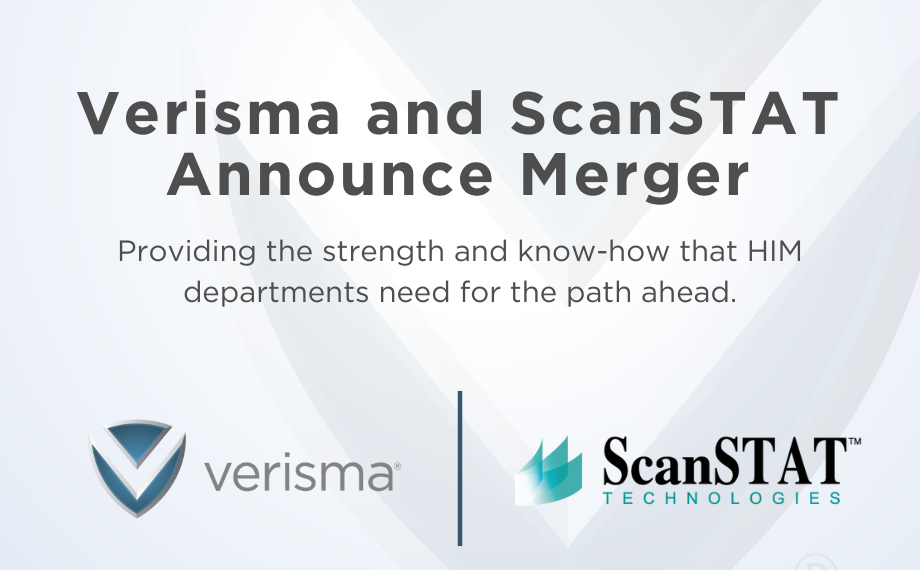

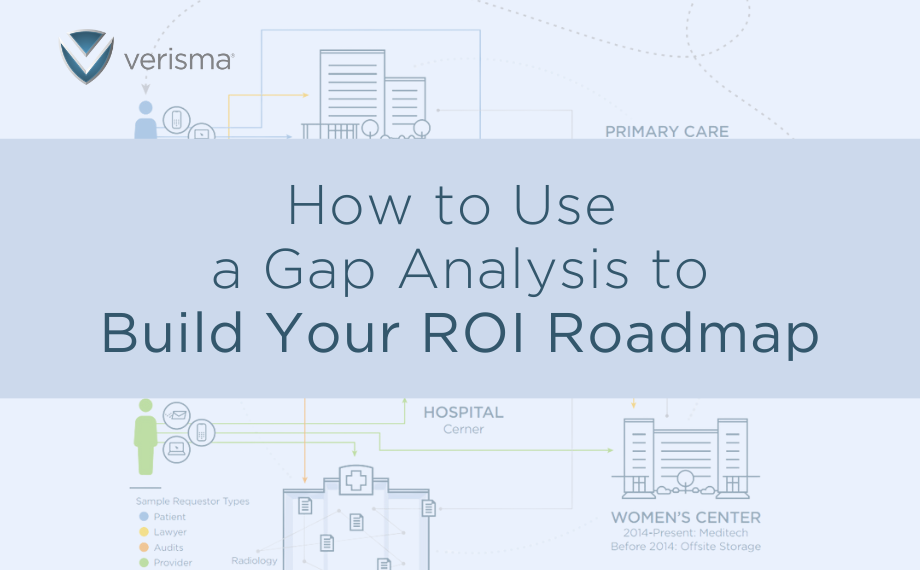
How to Use a Gap Analysis to Build Your ROI Roadmap
To begin a gap analysis, you must first assess your current state. We can break this down into six steps.
- Determine where the ROI flows into departments, practices, clinics, hospitals, etc.
- Layout a flowchart of all “on ramps.”
- Document the handling of all requests to include how many people touch a request. For example, does HIM forward a copy to radiology, the business office, sleep center, etc.?
- Analyze access to systems. Include all steps required to obtain access and what effort is needed to capture all pertinent information.
- Review current delivery method options (print, package, mail, email, fax, etc.)
- Determine current turn-around time. Start with the actual received date and remember that the TAT clock doesn’t stop and restart every time a request is forwarded to another department or location.
Once you’ve assessed your current state, it’s time to develop an action plan.
Working with a vendor partner who can automate this process will make this step much easier. Your action plan should involve a committee of location leaders or decision makers. You can use the “on ramp” flowchart from the previous step to make decisions on centralizing intake. Then provide access to all source systems to HIM or one centralized group. To reduce the number of patients wanting to review in-person, expand your delivery method options through automated technology like Verisma Request App®. Finally, establish a one-touch process to accomplish an accurate TAT.
The most difficult part of this process is building a unified ROI plan. Change projects are always challenging, especially within complex health systems, but your gap analysis will help as you move forward. Follow these five steps to build and implement your plan.
- Recognize the need for change. Get internal support and lay out your business case with benefits. HIM leadership should usually handle this step.
- Craft a vision. Your vendor partner can help you strategize for success.
- Implement change.
- Embed changes in your culture and practices. Make sure old ways aren’t creeping back in.
- Review your progress and analyze the results.
If you’d like to learn more about how Verisma can help you conduct a gap analysis and build an ROI roadmap, contact us.

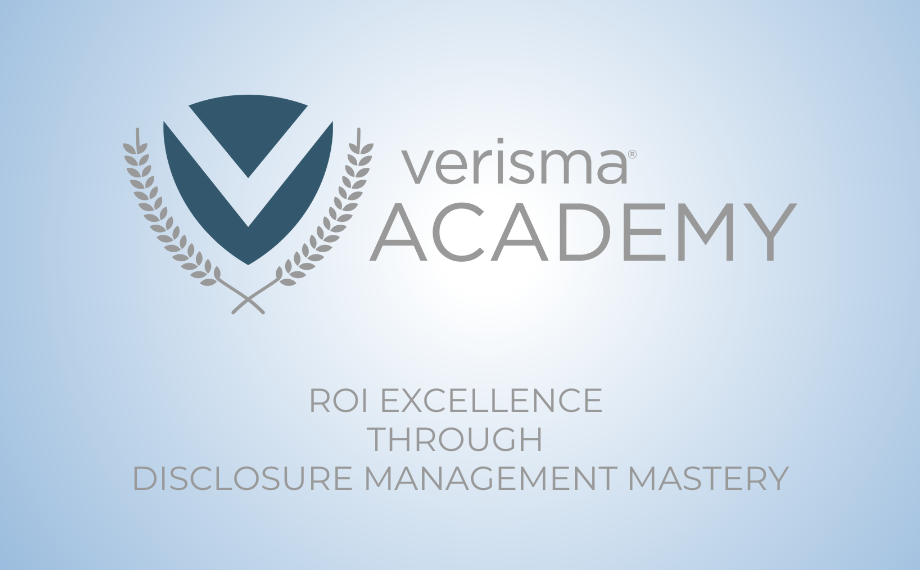
Verisma Launches Academy for Disclosure Management Mastery
Alexandria, VA, February 18, 2023 – Verisma, a leading provider of release of information and disclosure management solutions, is pleased to announce the launch of Verisma Academy, an educational program designed to advance excellence in release of information (ROI) through disclosure management mastery.
Once buried in paper charts, health information management (HIM) professionals now sit at the intersection of technology, patient/requestor experience, compliance, and revenue retention. ROI is part of this larger ecosystem we call disclosure management.
Navigating disclosure complexity is a challenge. Many professionals are heads-down in the operations of their own facility and struggle to stay up-to-date on external factors like regulation changes, cyber security threats, and hybrid workforce management. Siloed processes miss the big-picture impact on patient experience and the goals of the entire health system.
Verisma Academy offers the education and expertise to address these challenges. Standards of excellence in disclosure management will be taught by thought leaders from healthcare organizations, government agencies, and Verisma team members with decades of experience providing HIM solutions across the country.
Free enrollment in the academy includes live webinars, master classes, and on-demand courses, many of which are eligible for continuing education units (CEUs) through the American Health Information Management Association (AHIMA). State AHIMA chapters with the most enrollees will receive a $500 scholarship from Verisma to promote the future of HIM in their local area.
“We believe education is key to elevating the profession of health information management and advancing the industry as a whole,” said Marty McKenna, CEO of Verisma. “We envision Verisma Academy as a platform for sharing knowledge and fostering collaboration among professionals in the field, and we are excited to see the impact it will have on the HIM community.”
For more information and to enroll in Verisma Academy, visit verisma.com/academy.
Media Contact:
Delinda Tinkey
dtinkey@verisma.com
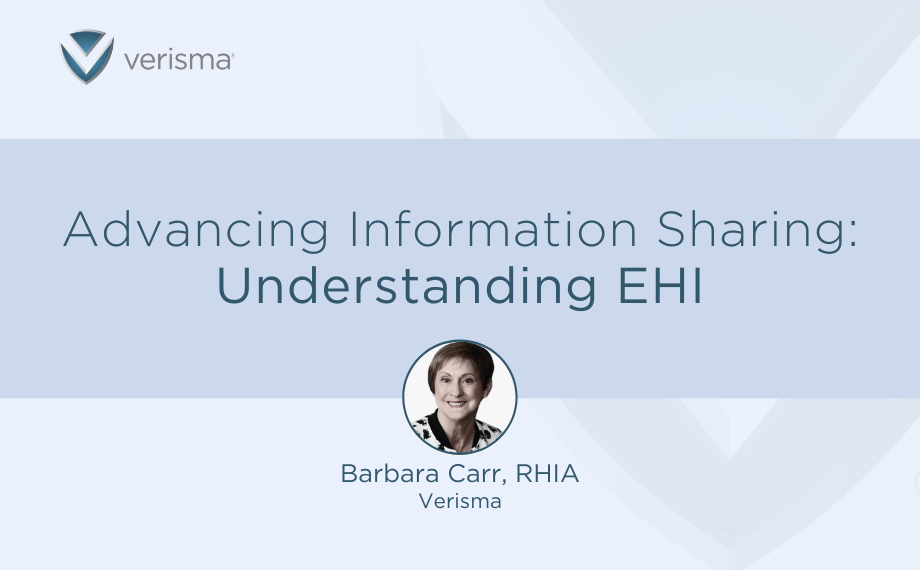
Advancing Information Sharing: Understanding EHI
What is and what is not EHI for purposes of information blocking regulations? In Verisma’s Nov 2022 ROI Roundtable Webinar we heard from two experts with the ONC – Rachel Nelson JD, Branch Chief, Compliance and Administration Branch, and Dan Healy, Policy Coordinator, Compliance and Administration Branch on what EHI is and how its definition relates to but differs from the definition of ePHI under the HIPAA Rules. The speakers provided important facts related to current information blocking policy and what healthcare organizations and providers should bear in mind specific to information blocking regulations as they review and update their technical capabilities and workflows in context of their DRS (Designated Record Set) to ensure they are sharing EHI consistent with all applicable laws. Some highlights from their presentation follow.
What is EHI as defined by the information blocking regulation? According to ONC, EHI is as follows:
- “Electronic Health Information (EHI) means electronic protected health information (ePHI) to the extent that the ePHI would be included in a designated record set as these terms are defined for HIPAA.”
The scope of EHI is relayed was shared in the following ONC graphic that can be found at HealthIT.gov:
The expansion is “only” PHI that is in an electronic format. Noted in the webinar is that EHI is “electronic health information (ePHI) to the extent that it would be included in a designated record set.” Further explained during the webinar was that EHI “is individually identifiable health information, that is maintained in electronic media or transmitted by electronic media.” If the ePHI is included in any of the following records and not in the exclusions such as psychotherapy notes, then it would be considered EHI:
- Medical records and billing records of a provider about an individual
- Enrollment, payment, claim adjudication, and case or medical management record systems maintained by or for a health plan.
- Records used in whole or in part to make decisions about individuals
What is not EHI was explained as well. For example, such things like psychotherapy notes, information complied in anticipation of, or for use in, a civil, criminal, or administrative action or proceeding, employment records health information, and de-identified protected health information. EHI is not limited by when the information was generated.
Organizations should be looking at what they now include in their designated record set policy and revise if necessary, to ensure the that their policy includes the full scope of EHI that is now in effect as of the October 6, 2022 expansion of the EHI definition beyond the current USCDI v.1 definition. Working with your Release of Information vendor is important as well, so they are aware of exactly what ePHI is defined in your designated record set and how to access all the ePHI for disclosure purposes. Many resources such as an EHI Fact Sheet, recorded Webinars, and an Infographic are available on https://www.healthit.gov/.
Dan and Rachel also spent time going over the Information Blocking definition and explaining how that relates directly to the exchange of ePHI. More details and explanation of the Information Blocking Regulation was shared with the attendees. Points that have caused some questions from health care providers and others in the health IT field were clarified. Information Blocking applies to “actors.” Actors are:
- Health Care Providers
- Health It Developers of Certified Health IT
- Health Information Networks (HINs)
- Health Information Exchanges (HIEs)
Exceptions to the Information Blocking Rule, which have caused a lot of questions from “actors,” in particular the “Content and Manner Exception” where it is not considered information blocking if the actor does not have all the requested EHI in their possession, cannot be shared using the technology requested, or where it must be “withheld due to laws or is permissible to be withheld, such as under the Preventing Har or Privacy exceptions.” One example would be if it would be impossible for an actor to segment out psychotherapy notes from the EHI. Another would be the cost to comply would be prohibitive. Other examples were given as well as resource information available on ONC’s Cures Act Final Rule website. For more in-depth information on Information Blocking, resources can be found at https://www.healthit.gov/ where there are fact sheets, Webinars, and FAQs.
Health Information Management leaders should be reviewing all the policies and procedures related to release of ePHI, especially their designated record set policy to ensure they are following the updated requirements that went into effect on October 6, 2022 and working closely to ensure their ROI vendor is up to date on all the requirements to ensure there are no risks of information blocking.
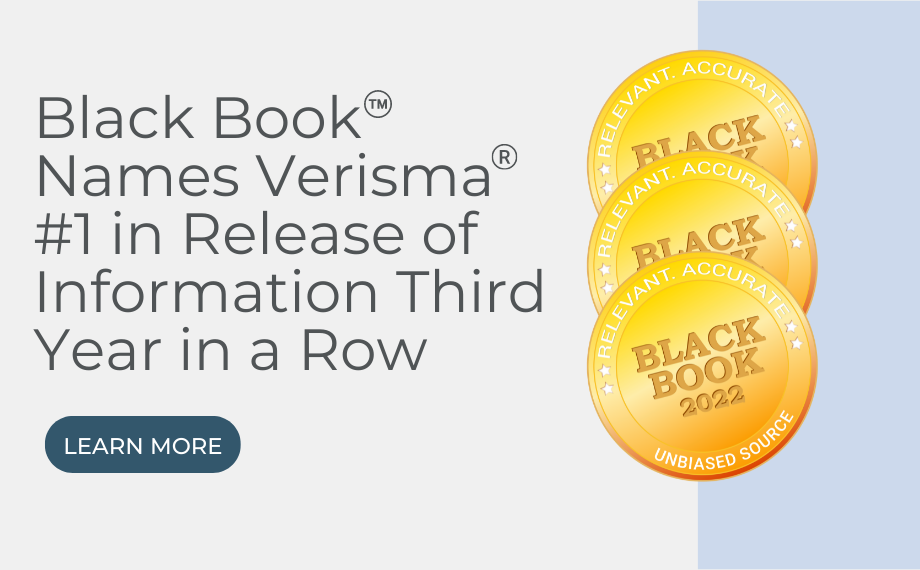
Black Book Names Verisma #1 in Release of Information Third Year in a Row
WASHINGTON, D.C., November 16, 2022 – For the third year in a row, Black BookTM Market Research ranked Verisma as the #1 vendor in Release of Information. After surveying users of ROI technology and services across the country, Verisma scored highest in 11 of the 18 data points measured. These include:
- Strategic alignment of client goals including VBC HIE ONC
- Innovation & optimization
- Training
- Client relationships and cultural fit
- Trust, accountability, transparency, ethics
- Deployment and implementation
- Integration and interfaces
- Reliability, consistency
- Marginal value adds and modules
- Support and customer care
- Best of breed technology and process improvement
Black Book’s unique research methodology focuses on front-end users of technology and services vs. executives who are more likely to have made the selection and purchase decisions of the vendors.
“As the Black Book information shows, our relationship with clients is our top priority,” said Verisma co-founder Andy McManus. “We have no way of telling who takes surveys like these, but our consistently high rank in a variety of measures three years in a row shows these are universal sentiments across our client base. It’s an honor to see this acknowledgement in the strength of our relationships and the solutions we provide.”
Full rankings for Release of Information Services & PHI Disclosure Management Solutions can be viewed at Black Book™ Announces Top Client-Rated Coding, Transcription, Clinical Documentation Improvement and Clinical Information Management Software and Services Vendors 2022 (apnews.com).
About Verisma
With Verisma® services and technology, health information managers elevate their organization’s method of securely disclosing confidential information to patients, attorneys, and other third parties. Built on the principles of truth and accuracy, Verisma is a trusted partner in complying with changing regulations while reducing errors, turnaround time, and cost. Verisma HITRUST® certified technology integrates with existing EHRs and portals for advanced automation and transparency uniquely designed for release of information (ROI), self-serve request tracking, and audits. Flexible service models including full-service, technology-only, or a hybrid seamlessly blend Verisma’s end-to-end solution with the needs of existing staff. Our partnership is truly a promise to put patient protection first.
Media Contact:
Delinda Tinkey
dtinkey@verisma.com
